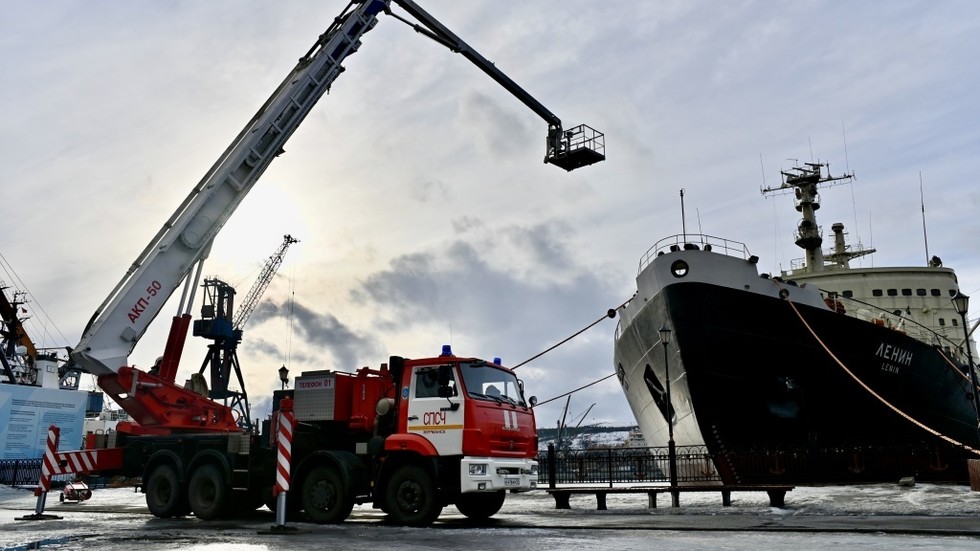Arctic Resilience: Understanding Fire Drills in Russia’s Icebreaker Hub
In a remarkable display of preparedness and commitment to maritime safety, Russia’s Arctic forum city recently conducted a sophisticated fire drill aimed at enhancing safety protocols within its icebreaker operations. As the Arctic region continues to evolve due to climate change and increased shipping traffic, the need for effective fire safety measures has never been more critical. This exercise not only underscores the complexities of conducting operations in one of the harshest environments on Earth but also highlights the importance of resilience in Arctic operations.
The Importance of Fire Drills in Arctic Operations
Fire drills in the Arctic, particularly in icebreaker hubs, play a vital role in ensuring the safety of personnel and the protection of valuable assets. The unique challenges presented by the Arctic environment—such as extreme cold, ice formations, and unpredictable weather—require specialized training and preparedness. Fire incidents can escalate quickly in such conditions, making regular drills essential.
Key Objectives of the Fire Drill
The recent fire drill in Russia’s icebreaker hub had several key objectives:
- Assessing Response Times: Evaluating how quickly teams can respond to a fire emergency, which is crucial in the Arctic’s unforgiving environment.
- Testing Equipment: Ensuring that firefighting equipment and systems are functional and ready for immediate deployment.
- Training Personnel: Providing hands-on training for crew members in firefighting techniques specific to icebreaker operations.
- Promoting Coordination: Enhancing communication and coordination among various teams during an emergency situation.
The Challenges of Fire Safety in the Arctic
Fire safety in the Arctic poses unique challenges that differentiate it from other maritime operations. Here are some of the most pressing issues:
Extreme Weather Conditions
The Arctic is characterized by harsh weather conditions, including sub-zero temperatures and strong winds. These factors can hinder firefighting efforts significantly. For example, water used to extinguish fires can freeze rapidly, making traditional firefighting methods less effective. Therefore, training must focus on innovative techniques tailored to these conditions.
Limited Accessibility
Accessibility is another major concern. Many icebreakers operate in remote areas where immediate assistance may not be available. This isolation necessitates that crews are equipped to handle emergencies on their own, reinforcing the importance of regular drills and training sessions.
Risk of Environmental Impact
Fires on vessels pose a dual threat: they endanger lives and can lead to significant environmental damage. An uncontrolled fire could result in oil spills or the release of hazardous materials into the pristine Arctic ecosystem. This reality underscores the importance of rigorous training and preparedness to minimize risks.
Technological Advancements in Fire Safety
As the Arctic region becomes increasingly navigable, technological advancements are playing a crucial role in enhancing fire safety. Innovations in firefighting technology and training methods have emerged, making operations safer and more efficient.
Advanced Firefighting Equipment
Modern icebreakers are now equipped with advanced firefighting systems, including:
- Automated Fire Detection Systems: These systems can identify fires early, allowing crews to respond more quickly.
- High-Pressure Water Systems: Designed to operate effectively even in freezing temperatures, these systems can deliver water in a controlled manner.
- Fire-Resistant Materials: The use of fire-resistant materials in vessel construction helps contain potential fires and slow their spread.
Simulation-Based Training
Simulation-based training is becoming increasingly popular in Arctic fire drills. Utilizing virtual reality (VR) and augmented reality (AR) technologies, crews can practice emergency scenarios in a controlled environment. This approach allows them to experience realistic situations without the associated risks.
Community Involvement and International Cooperation
The success of fire drills and safety measures often extends beyond the immediate crews involved. Community involvement and international cooperation are critical components of Arctic resilience.
Engaging Local Communities
Local communities play an essential role in Arctic operations. By engaging with indigenous populations and local stakeholders, icebreaker operations can incorporate traditional knowledge and practices that enhance safety and environmental stewardship. These collaborations can foster greater understanding and bring about innovative solutions to common challenges.
International Partnerships
Given the global nature of Arctic shipping, international cooperation is crucial. Countries operating in the Arctic often participate in joint exercises and share best practices regarding fire safety and emergency response. Such collaborations enhance collective knowledge and preparedness, benefiting all stakeholders in the region.
The Future of Fire Safety in Arctic Operations
As climate change continues to reshape the Arctic landscape, the dynamics of maritime operations are evolving. Increasingly, the region is seeing a rise in shipping traffic, tourism, and resource extraction, all of which necessitate heightened safety measures. Fire drills in Russia’s icebreaker hub serve as a model for how to approach these challenges.
Emphasizing Continuous Improvement
Moving forward, a culture of continuous improvement must be ingrained within Arctic operations. Regular reviews of safety protocols, incorporation of new technologies, and commitment to ongoing training will be essential in adapting to the ever-changing environment of the Arctic.
Conclusion
In conclusion, fire drills in Russia’s icebreaker hub are a testament to the commitment to safety and resilience in the Arctic region. As the challenges of operating in such a unique environment grow, so too must the strategies for ensuring safety and preparedness. Through advanced training, community engagement, and international cooperation, stakeholders can work towards a safer and more resilient Arctic for all.
See more Your Daily Weather



